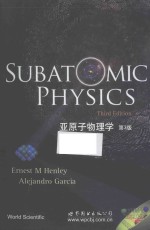图书介绍
亚原子物理学 第3版 英文版PDF|Epub|txt|kindle电子书版本网盘下载

- (美)亨利(ErnestM.Henley),AlejandroGarcia著 著
- 出版社: 北京:世界图书北京出版公司
- ISBN:9787510086359
- 出版时间:2015
- 标注页数:620页
- 文件大小:91MB
- 文件页数:639页
- 主题词:原子物理学-教材-英文
PDF下载
下载说明
亚原子物理学 第3版 英文版PDF格式电子书版下载
下载的文件为RAR压缩包。需要使用解压软件进行解压得到PDF格式图书。建议使用BT下载工具Free Download Manager进行下载,简称FDM(免费,没有广告,支持多平台)。本站资源全部打包为BT种子。所以需要使用专业的BT下载软件进行下载。如BitComet qBittorrent uTorrent等BT下载工具。迅雷目前由于本站不是热门资源。不推荐使用!后期资源热门了。安装了迅雷也可以迅雷进行下载!
(文件页数 要大于 标注页数,上中下等多册电子书除外)
注意:本站所有压缩包均有解压码: 点击下载压缩包解压工具
图书目录
1 Background and Language1
1.1 Orders of Magnitude1
1.2 Units3
1.3 Special Relativity,Feynman Diagrams4
1.4 References8
Ⅰ Tools11
2 Accelerators13
2.1 Why Accelerators?13
2.2 Cross Sections and Luminosity16
2.3 Electrostatic Generators(Van de Graaff)18
2.4 Linear Accelerators(Linacs)20
2.5 Beam Optics22
2.6 Synchrotrons24
2.7 Laboratory and Center-of-MomentumFrames29
2.8 Colliding Beams31
2.9 Superconducting Linacs31
2.1 0 Beam Storage and Cooling32
2.1 1 References34
3 Passage of Radiation Through Matter39
3.1 Concepts39
3.2 Heavy Charged Particles41
3.3 Photons45
3.4 Electrons46
3.5 Nuclear Interactions49
3.6 References50
4 Detectors53
4.1 Scintillation Counters53
4.2 Statistical Aspects56
4.3 Semiconductor Detectors59
4.4 Bubble Chambers62
4.5 Spark Chambers64
4.6 Wire Chambers65
4.7 Drift Chambers66
4.8 Time Projection Chambers67
4.9 ?erenkov Counters68
4.10 Calorimeters69
4.11 Counter Electronics70
4.12 Electronics:Logic72
4.13 References73
Ⅱ Particles and Nuclei77
5 The Subatomic Zoo79
5.1 Mass and Spin.Fermions and Bosons79
5.2 Electric Charge and Magnetic Dipole Moment84
5.3 Mass Measurements87
5.4 A First Glance at the Subatomic Zoo92
5.5 Gauge Bosons94
5.6 Leptons97
5.7 Decays98
5.8 Mesons103
5.9 Baryon Ground States105
5.10 Particles and Antiparticles108
5.11 Quarks,Gluons,and Intermediate Bosons112
5.12 Excited States and Resonances118
5.13 Excited States of Baryons122
5.14 References128
6 Structure of Subatomic Particles135
6.1 The Approach:Elastic Scattering135
6.2 Rutherford and Mott Scattering136
6.3 Form Factors140
6.4 The Charge Distribution of Spherical Nuclei143
6.5 Leptons Are Point Particles147
6.6 Nucleon Elastic Form Factors153
6.7 The Charge Radii of the Pion and Kaon160
6.8 Inelastic Electron and Muon Scattering161
6.9 Deep Inelastic Electron Scattering164
6.10 Quark-Parton Model for Deep Inelastic Scattering166
6.11 More Details on Scattering and Structure172
6.12 References189
Ⅲ Symmetries and Conservation Laws195
7 Additive Conservation Laws197
7.1 Conserved Quantities and Symmetries197
7.2 The Electric Charge203
7.3 The Baryon Number206
7.4 Lepton and Lepton Flavor Number208
7.5 Strangeness Flavor211
7.6 Additive Quantum Numbers of Quarks214
7.7 References216
8 Angular Momentum and Isospin221
8.1 Invariance Under Spatial Rotation221
8.2 Symmetry Breaking by a Magnetic Field223
8.3 Charge Independence of Hadronic Forces224
8.4 The Nucleon Isospin225
8.5 Isospin Invariance226
8.6 Isospin of Particles228
8.7 Isospin in Nuclei232
8.8 References235
9 P,C,CP,and T239
9.1 The Parity Operation239
9.2 The Intrinsic Parities of Subatomic Particles243
9.3 Conservation and Breakdown of Parity247
9.4 Charge Conjugation252
9.5 Time Reversal256
9.6 The Two-State Problem260
9.7 The Neutral Kaons263
9.8 The Fall of CP Invariance268
9.9 References271
Ⅳ Interactions279
10 The Electromagnetic Interaction281
10.1 The Golden Rule281
10.2 Phase Space286
10.3 The Classical Electromagnetic Interaction289
10.4 Photon Emission292
10.5 Multipole Radiation299
10.6 Electromagnetic Scattering of Leptons303
10.7 Vector Mesons as Mediators of the Photon-Hadron Interaction307
10.8 Colliding Beams311
10.9 Electron-Positron Collisions and Quarks314
10.10 The Photon-Hadron Interaction:Real and Spacelike Photons317
10.11 Magnetic Monopoles323
10.12 References324
11 The Weak Interaction331
11.1 The Continuous Beta Spectrum331
11.2 Beta Decay Lifetimes335
11.3 The Current-Current Interaction of the Standard Model337
11.4 A Variety of Weak Processes342
11.5 The Muon Decay346
11.6 The Weak Current of Leptons348
11.7 Chirality versus Helicity353
11.8 The Weak Coupling Constant GF354
11.9 Weak Decays of Quarks and the CKM Matrix355
11.10 Weak Currents in Nuclear Physics356
11.11 Inverse Beta Decay:Reines and Cowan's Detection of Neutrinos361
11.12 Massive Neutrinos363
11.13 Majorana versus Dirac Neutrinos365
11.14 The Weak Current of Hadrons at High Energies366
11.15 References375
12 Introduction to Gauge Theories383
12.1 Introduction383
12.2 Potentials in Quantum Mechanics—The Aharonov-Bohm Effect386
12.3 Gauge Invariance for Non-Abelian Fields388
12.4 The Higgs Mechanism;Spontaneous Symmetry Breaking393
12.5 General References401
13 The Electroweak Theory of the Standard Model403
13.1 Introduction403
13.2 The Gauge Bosons and Weak Isospin404
13.3 The Electroweak Interaction408
13.4 Tests of the Standard Model414
13.5 References418
14 Strong Interactions421
14.1 Range and Strength of the Low-Energy Strong Interactions422
14.2 The Pion-Nucleon Interaction—Survey425
14.3 The Form of the Pion-Nucleon Interaction430
14.4 The Yukawa Theory of Nuclear Forces432
14.5 Low-Energy Nucleon-Nucleon Force434
14.6 Meson Theory of the Nucleon-NucleonForce442
14.7 Strong Processes at High Energies445
14.8 The Standard Model,Quantum Chromodynamics451
14.9 QCD at Low Energies456
14.10 Grand Unified Theories,Supersymmetry,String Theories458
14.11 References460
Ⅴ Models469
15 Quark Models of Mesons and Baryons471
15.1 Introduction471
15.2 Quarks as Building Blocks of Hadrons472
15.3 Hunting the Quark474
15.4 Mesons as Bound Quark States475
15.5 Baryons as Bound Quark States478
15.6 The Hadron Masses480
15.7 QCD and Quark Models of the Hadrons483
15.8 Heavy Mesons:Charmonium,Upsilon491
15.9 Outlook and Problems493
15.10 References494
16 Liquid Drop Model,Fermi Gas Model,Heavy Ions501
16.1 The Liquid Drop Model501
16.2 The Fermi Gas Model506
16.3 Heavy Ion Reactions508
16.4 Relativistic Heavy Ion Collisions511
16.5 References515
17 The Shell Model521
17.1 The Magic Numbers522
17.2 The Closed Shells524
17.3 The Spin-Orbit Interaction529
17.4 The Single-Particle Shell Model531
17.5 Generalization of the Single-Particle Model533
17.6 Isobaric Analog Resonances535
17.7 Nuclei Far From the Valley of Stability537
17.8 References538
18 Collective Model543
18.1 Nuclear Deformations544
18.2 Rotational Spectra of Spinless Nuclei547
18.3 Rotational Families551
18.4 One-Particle Motion in Deformed Nuclei(Nilsson Model)554
18.5 Vibrational States in Spherical Nuclei558
18.6 The Interacting Boson Model562
18.7 Highly Excited States;Giant Resonances564
18.8 Nuclear Models—Concluding Remarks567
18.9 References570
19 Nuclear and Particle Astrophysics579
19.1 The Beginning of the Universe579
19.2 Primordial Nucleosynthesis585
19.3 Stellar Energy and Nucleosynthesis586
19.4 Stellar Collapse and Neutron Stars592
19.5 Cosmic Rays596
19.6 Neutrino Astronomy and Cosmology601
19.7 Leptogenesis as Basis for Baryon Excess602
19.8 References603
Index609